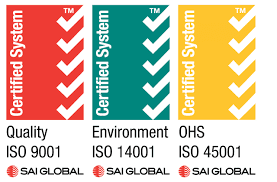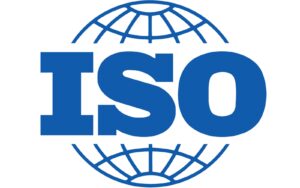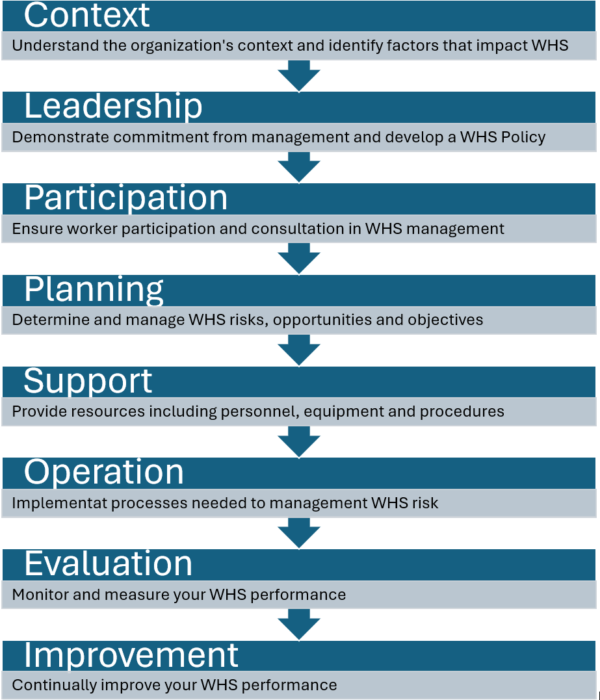What is ISO Accreditation?
What is ISO Accreditation?
 The terms ISO Certification and ISO Accreditation are used interchangeably and usually refer to the fact that an organization has been certified that it complies with ISO standards.
The terms ISO Certification and ISO Accreditation are used interchangeably and usually refer to the fact that an organization has been certified that it complies with ISO standards.
However, this raises further questions, like:
- What is ISO?
- What are their standards? and
- How does an organization get certified?
What is “ISO”?
ISO is an organization based in Geneva, Switzerland. It is the symbol for the “International Organization for Standardization”. ISO is not an acronym, it is simply a logo or slogan as it derived from the Greek word “isos” meaning “equal”.
 The International Organization for Standardization (ISO) has members from 167 countries and publishes all sorts of standards covering a myriad of subjects from seatbelts to snowmobiles. This type of global standardization gives the world some confidence in international goods and services and promotes further integration of the global economy.
The International Organization for Standardization (ISO) has members from 167 countries and publishes all sorts of standards covering a myriad of subjects from seatbelts to snowmobiles. This type of global standardization gives the world some confidence in international goods and services and promotes further integration of the global economy.
What is an ISO Standard?
ISO standards are essentially documents that outline the requirement a particular product or process must meet. For example, to be certified as compliant with ISO6683:2005 Earth Moving Machinery Seatbelts, the seatbelt needs to meet performance requirements for strength, durability and reliability.
Standards not only exist for physical products, but also for intangibles. In the case of ISO45001, 9001 and 14001 – these intangibles are management systems.
The main ISO standards for management systems used in Australia are:
- ISO45001 – Occupational Health and Safety Management Systems
- ISO9001 – Quality Management Systems, and
- ISO14001 – Environmental Management Systems
Inside the standard is detailed information on how to meet the requirements.

For example, ISO45001 – Occupational Health and Safety Management Systems includes sections on:
- Context of the organisation: Internal and external issues
- Leadership and worker participation: Commitment, policies and roles / responsibilities
- Planning: Hazard ID, risk assessment, determination of legal requirements
- Objectives and targets: A set of self-made targets and plans to achieve them
- Competency: What competencies should various stakeholders maintain
- Communication: Internal and external communication between stakeholders
- Document control: How documents are created, stored, distributed and collected
- Monitoring and measuring: Tracking ongoing performance, including internal audits
- Improvements: Identification and rectification of non-conformance and continual improvement
Once an organization has documented plans, policies and procedures that meet (or exceed) the requirements outlined in ISO, it is ready to become certified.
How Does an Organisation Get ISO Accreditation?
The easiest way to get certified is to call us now. We can typically get a company certified for ISO 45001 (as well as 9001 and 14001) for around $20,000 total cost (including certification audit).
The timeline for us to develop a ISO 45001 compliant WHS Management Systems (or a 45001, 9001 and 14001 integrated management system) is typically 6 weeks development + 1 week for the certification audit = about 7 weeks total.
Step 1: Gap Analysis (SKIP THIS?)
Many consultants will start with a gap analysis to identify gaps in your existing system, with the goal of filling these gaps to achieve certification. In our experience, many clients do not need a gap analysis and their journey starts at Step 2 below.
Even if the company has existing WHS documentation or systems, it is usually simplest and easiest to begin with a new WHS Management System and simply “add-in” any existing documents or procedures that will add value to the new system (quite often a lot of the old documentation is retired or archived).
Step 2: Getting a WHSMS
Option 1 – Purchase “Off-The-Shelf” WHSMS
Purchasing an off-the-shelf system is fastest and cheapest. This WHSMS will be generic in nature, but workplace-specific documentation can be added to the system.
Its similar to how you would make a homemade pizza – you are likely to buy the pizza base (or even a plain cheese pizza) from the supermarket, and then add your own choice of toppings. Then, bam! You have your own customized and workplace-specific WHS Management System (or pizza! or both!).
Option 2 – Write the WHSMS From Scratch
This option could be a lengthy process – and it will likely need to be written by someone with experience (or a consultant). For example, the WHSMS Manual is typically 20 – 50 pages (or longer). The entire system could take months to create – why reinvent the wheel?
Step 3: Overview of Operations
The next steps assume you have purchased an off-the-shelf system and engaged a consultant (hopefully us!) to assist.
The real work begins! We need to learn about your company’s:
- Operations
- Staff
- Work Sites / Locations
Step 4: Develop Company-Specific Documentation
Company-specific documents may include SWMS, Permit Systems or Inductions. In addition to the front-end documents, the back-end documents including Policies, Procedures and Registers (or spreadsheets) are developed. To learn about WHS Policies and Procedures, read our detailed guide.
Step 5: Implement the WHSMS
Now, use the system! This can include inducting staff (with the new induction tool) and implementing Safe Work Procedures (SWPs or SWMS). You also need to conduct the following:
- Safety Inspection
- Safety Meeting (and distribute a Safety Alert)
- Emergency Drill
- Management Review Meeting
- Internal Audit (we help with this step)
You will also need to ensure your workplace is safe and well-managed. For example, ensuring first aid kits and fire extinguishers are available.
Step 6: Third-Party Audit (The Easy Step)
Now you can sit back and let the auditor admire your WHS Management System. A third-party auditor will review your documentation and workplace. There will be corrective actions (i.e. stuff that needs fixing). However, we have a 100% success rate and have never failed an audit.
Step 7: Get Your ISO Accreditation Certificates
You will be issued with certificate/s which you can display on your website and submit for tenders.
Step 8: Keep Your Certificates
You will required “surveillance audits” yearly and “re-certification audits” every 3 years to maintain your ISO Accreditation.
FAQs
What is ISO Accreditation?
ISO Accreditation is a formal recognition that a certification body is competent to audit and certify organizations to ISO management system standards.
What are Management System Standards?
These are standards like ISO 9001 (Quality Management), ISO 14001 (Environmental Management), and ISO/IEC 27001 (Information Security Management) that help organizations ensure their processes meet international best practices.
Why is ISO Accreditation important?
It ensures that the certification body is impartial and competent, providing confidence in the certification process and the certified organization’s management systems.
How do I get my organization ISO Accreditation?
You need to implement the relevant ISO standard and then undergo an audit by an accredited certification body.
How long does ISO Accreditation last?
ISO certifications are typically valid for three years, with annual surveillance audits to ensure ongoing compliance4.
Can ISO Accreditation help my business?
Yes, it can improve efficiency, customer satisfaction, and marketability. Some clients may require ISO certification as a condition for doing business.
Did You Know?
Did you know that the first ISO management system standard, ISO 9001, was based on a British standard? The ISO 9001 standard, which focuses on quality management systems, was first published in 1987. It was based on the British Standard BS 5750, which was developed in 1979. This standard has since become one of the most widely recognized and implemented management system standards globally.
Articles and Further Reading
- What is ISO 45001 Certification and How Do I Get Certified? (Spire Safety) <https://spiresafety.com.au/resources/iso-45001-certification/>
- ISO 45001 Occupational Health and Safety Management System (SAI Global) <https://saiassurance.com.au/iso-45001>
